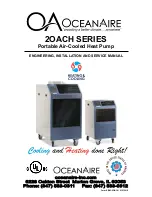
31
Tube Cleaning Procedure
Establish a regular inspection schedule, the frequency
depending on the local water conditions and the severity
of service. Do not let the tubes clog up solidly. Clean out
deposits over 1/16" (1.6 mm) in thickness.
The heater may be cleaned from the return header
side, without breaking pipe connections. It is preferable,
however, to remove both headers for better visibility
through the tubes and to be sure the ground-up lime dust
does not get into the system. Note that you do not remove
the top panel or the heater exchanger, generally.
After reaming, mount the wire brush in place of the auger
and clean out debris remaining in the tubes.
Another method is to remove the heat exchanger, ream
tubes and immerse heat exchanger in non-inhibited de-
scale solvent for severe scale build-up.
Extension
Pieces (2)
Auger
with Carbide Tip
Wire Brush
Figure 48. Tube Cleaning Kit
Desooting Procedure
A
WARNING:
Soot Is Combustible. Exercise Extreme
Care.
Soot will clog areas between fins and cause eventual
tube failure. Any sign of soot at the base of the burners or
around the outer jacket indicates a need for cleaning.
1. Remove top and flue collector from cabinet.
2. Remove “V” baffles from heat exchanger.
3. Remove burner tray. See
page 30
.
4.
If ProTek Shield Assy is attached to heater, remove
ProTek Shield Assy bonding wire from heat exchanger
stud.
5. Remove heat exchanger from the heater and wash
with a garden hose, making sure soot is removed
from spaces between fins.
6.
Reverse above procedure to reinstall.
NOTE:
In extreme cases it may be necessary to do
steam cleaning at the local car wash. DO NOT WIRE
BRUSH.
Combustion Chamber Removal
To remove combustion chamber, you must first have
removed the heat exchanger.
F10723
Figure 49. Refractory Panels
A
WARNING:
When removing the burners or heat
exchangers, take precautions to avoid creating airborne
dust and avoid inhaling airborne fibers. When cleaning
spills, use wet sweeping or High Efficiency Particulate
Air (HEPA) filtered vacuum to minimize airborne dust.
Use feasible engineering controls such as local exhaust
ventilation or dust collecting systems to minimize
airborne dust. Wear appropriate personal protective
equipment including gloves, safety glasses with side
shields, and appropriate NIOSH certified respiratory
protection, to avoid inhalation of airborne dust and
airborne fiber particles.
Unitherm Governor (U.G.) Replacement
1. Shut water, gas and electricity off, close valves and
relieve pressure.
2. Drain heat exchanger.
3. Remove UG/Bypass Valve Assy located on the right
side of the header. See .
Figure 50
.
4.
Reinstall UG/Bypass Valve Assy, taking care to
lubricate gasket with a non-petroleum based grease
such as AquaLube.
F10642-2
UG/BYPASS ASSY
UNITHERM
GOVERNOR
Figure 50. Unitherm Governor/Bypass Valve Assy
NOTE:
The U.G. on bronze header models (ASME)
can only be replaced by replacing the entire Unitherm
Governor/Bypass Valve Assembly.
RELEASED
For Reference Only














































